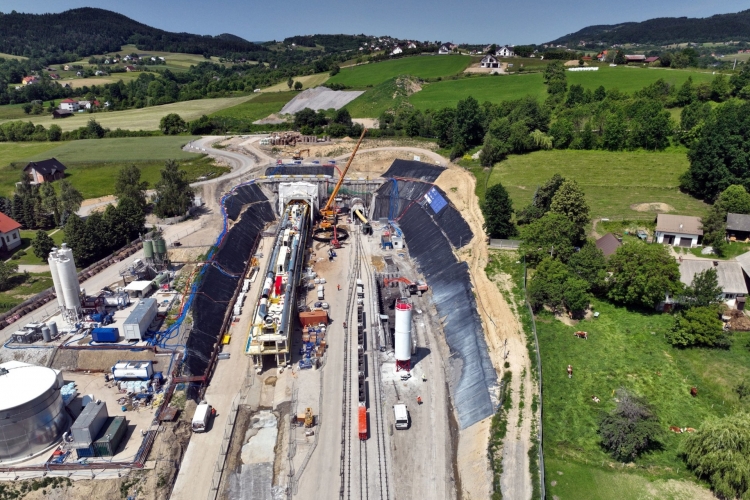Excavation of the longest railway tunnel in Poland
- Oprac. M.K.
- Kategoria: English zone
The TBM cutterhead “Jadwiga”, weighing more than 2.5 thousand tonnes, has begun building a railway tunnel beneath Pisarzowa. Over the next year an almost 4 km long structure will be created, shortening train journeys between Limanowa and Nowy Sącz. It will be the first of sixteen such structures planned within the Podłęże-Piekiełko project, the largest Polish Railway Lines investment in the south of the country. The task is co-financed by the European Union under the National Recovery and Resilience Plan.
Tunnel excavation between Męcina and Mordarka is under way. It is being carried out by the larger of the two tunnel-boring machines working on the site. Jadwiga weighs more than 2.5 thousand tonnes and is 90 metres long. An ambitious challenge awaits the machine and the specialists who operate it: they must drive exactly 3.750 metres of underground route. The structure, almost 11 metres in diameter, is being built step by step with millimetre accuracy. Using its rotating head fitted with steel teeth, the TBM simultaneously removes soil and installs the concrete tunnel lining. Behind it heavy machinery and an industrial rail conveyor remove excavated spoil and, in the opposite direction, deliver concrete lining segments produced round the clock in a nearby precast plant. The entire operation is scheduled to take about ten months of continuous work.
The railway workers and contractors face an ambitious task. The coming months will be hard work on the construction of the longest railway tunnel in Poland. I am pleased that the investment is progressing according to plan. It will give the region new opportunities for economic and social development - said Minister of Infrastructure Dariusz Klimczak.
A total of two tunnels will be built beneath Pisarzowa. In addition to the rail tunnel, the smaller evacuation tunnel has been driven since the end of March by the TBM named “Kinga”. In that time the machine has already completed 420 metres, and the figure is growing every day. These will be the first tunnels completed for the Podłęże-Piekiełko project. Altogether twenty such structures will be built as part of the largest Polish Railway Lines investment in southern Poland. Trains will run in sixteen of them, which together will total almost 21 km. The remaining four will be evacuation tunnels with a combined length of about 10 km.
This is one of the most difficult projects currently undertaken by Polish Railway Lines. We are laying tracks on an entirely new alignment in very demanding terrain. We are preparing to build the next sections of this largest railway investment in the south of the country - said Marcin Mochocki, Management Board Member of Polish Railway Lines S.A.
Rail line modernization
The longest railway tunnel in Poland, which will be built near Limanowa, is part of the new alignment of rail line No. 104. Modernization of the Limanowa-Klęczany siding section is being carried out by a consortium of Budimex S.A., Gülermak Ağir Sanayi İnşaat ve Taahhüt A.Ş. and Gülermak Sp. z o.o. at a cost of more than PLN 1.9 billion. It is one of four parts of the Podłęże-Piekiełko project where construction works are already under way; the others are Limanowa station and the Klęczany siding-Nowy Sącz and Chabówka-Rabka Zaryte sections. Tender procedures are in progress for four further sections: Rabka Zaryte-Mszana Dolna-Fornale (Kasina Wielka), Szczyrzyc-Tymbark, Tymbark-Limanowa and Podłęże-Gdów.
The Podłęże-Piekiełko project comprises modernization and electrification of 75 km of the Chabówka-Nowy Sącz route and construction of 58 km of new line that will ultimately link Podłęże with Tymbark and Mszana Dolna. This will create a new connection that will facilitate travel between Kraków, Podhale and the Sądecczyzna region. The fastest trains will cover the Kraków-Nowy Sącz route in about 60 minutes, while the journey from the capital of Małopolska to Zakopane will take about 90 minutes. Parts of this investment are financed under the National Recovery and Resilience Plan.
Source: PKP Polskie Linie Kolejowe S.A.


